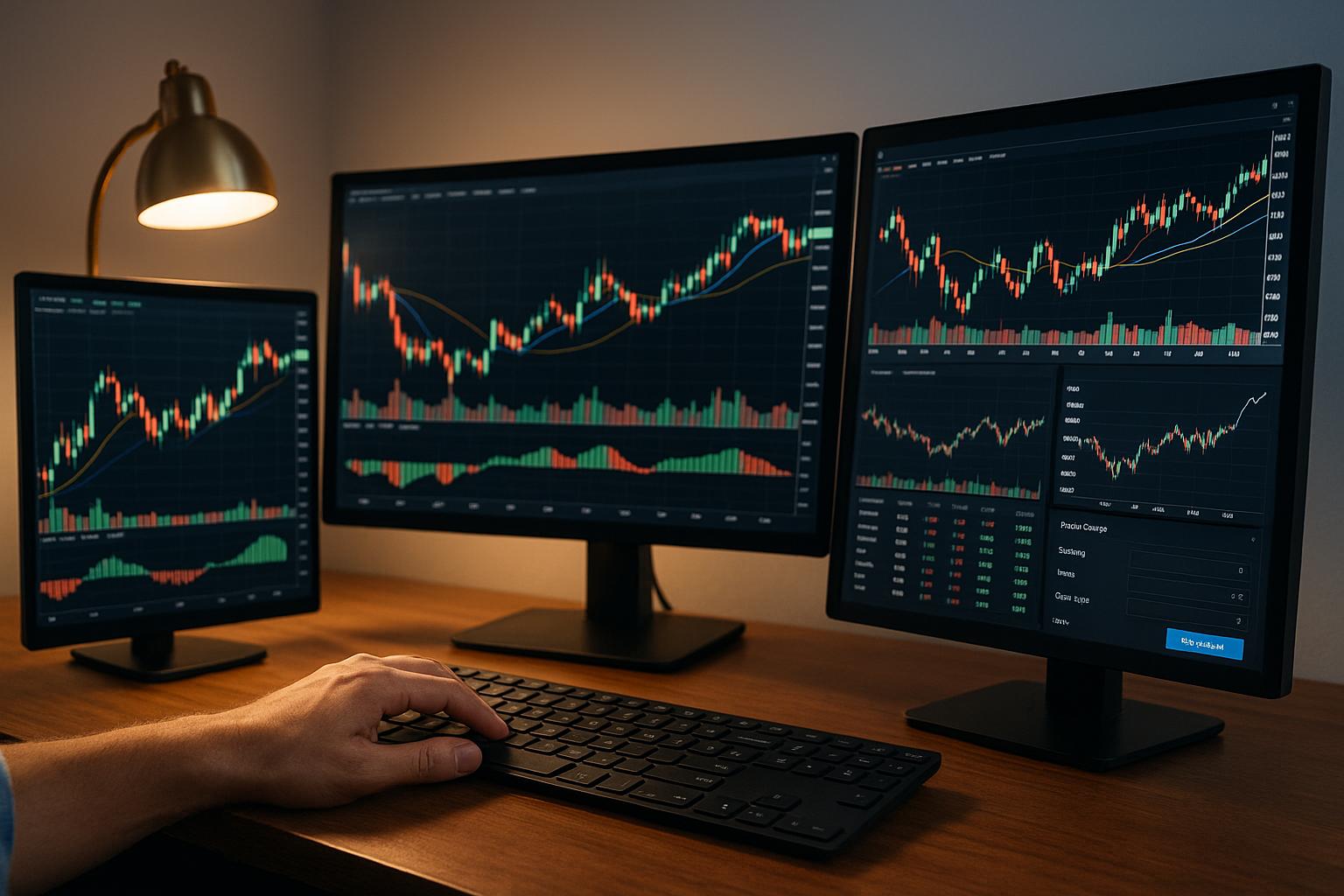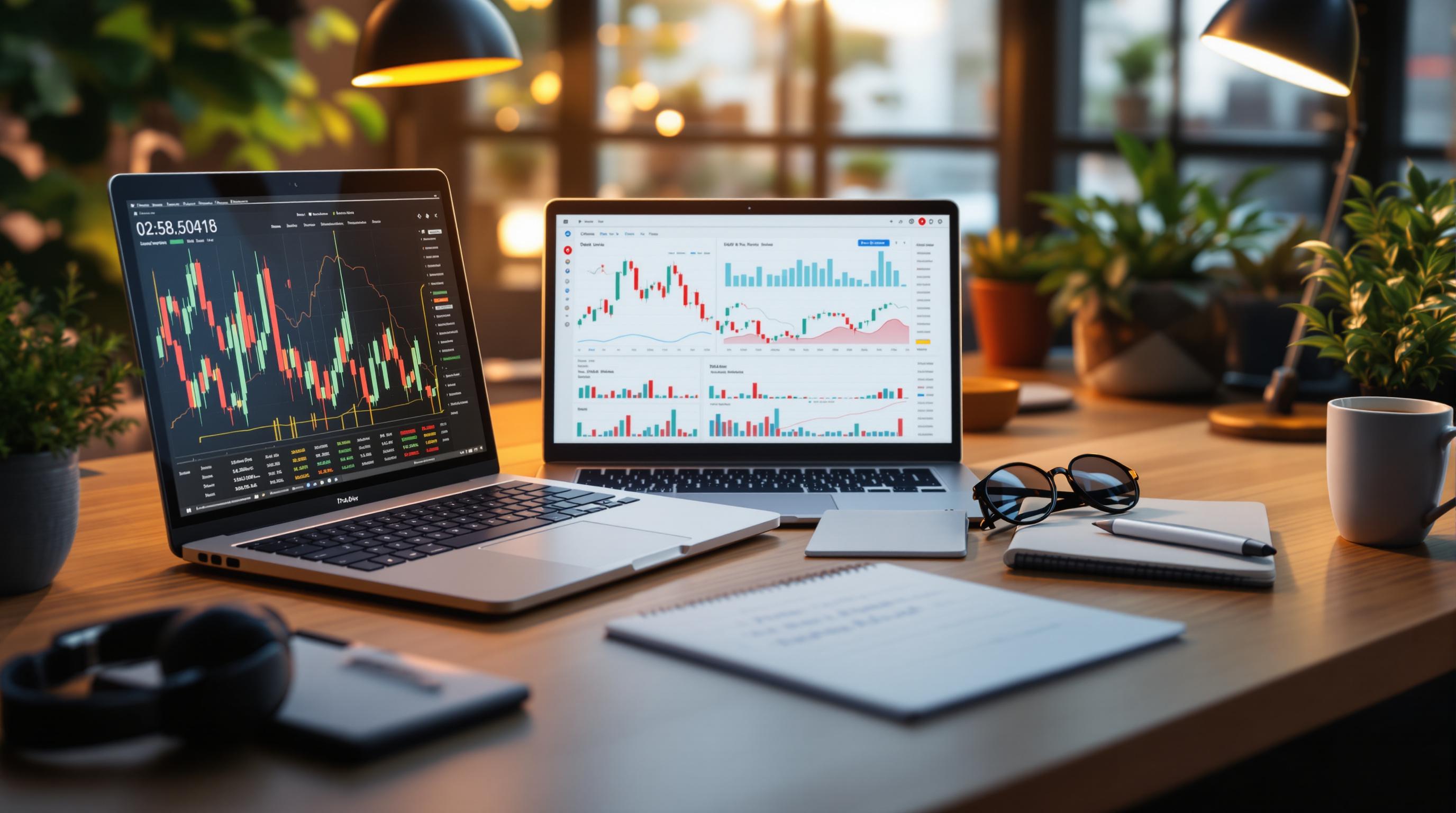Free AI tools are making quantitative trading accessible to more people by offering features that were once exclusive to large institutions. These tools use advanced algorithms to analyze data, automate strategies, and execute trades efficiently. Here’s what you need to know:
- Automated strategy development: AI tools create strategies tailored to specific markets, analyzing thousands of securities in real time. They save time and reduce the need for coding expertise.
- Backtesting and historical data analysis: Traders can simulate past performance to refine strategies, minimizing risks before using real money.
- Customizable technical analysis: Platforms offer built-in indicators and support for custom scripts, catering to different trading styles and skill levels.
Popular free platforms include QuantConnect, TradingView, and Kavout, each offering unique features like algorithm development, charting tools, and AI-driven insights. While these tools lower costs and improve efficiency, they also come with challenges like reliance on historical data and the need for constant oversight.
AI is reshaping trading by bridging the gap between individual traders and institutions, but success still requires combining AI's capabilities with human judgment.
How to Use AI In Trading - Copy This (Free & Easy)
Key Features of Free AI Tools for Quantitative Trading
Free AI tools have transformed quantitative trading, bringing advanced capabilities that were once limited to institutional investors. Let’s take a closer look at three standout features driving this shift.
Automated Strategy Development
AI-powered platforms now make it possible to generate trading strategies automatically, tailored to specific market preferences and inputs. Instead of spending weeks coding, traders can rely on these tools to process massive amounts of market data, uncover patterns, and create strategies with impressive efficiency. These aren’t just basic rule-based systems; advanced AI algorithms can deliver insights and predictions with up to 95% accuracy, making it easier to identify trading opportunities that might otherwise go unnoticed. While human traders might analyze a handful of stocks in a day, AI tools can assess thousands of securities in real time. This is significant when you consider that algorithmic trading accounts for about 70% of the total trading volume in the US. Many platforms also feature user-friendly visual interfaces, enabling traders to tweak rules and strategies without any coding knowledge. This level of automation not only saves time but also enhances backtesting and allows for greater customization.
Backtesting and Historical Data Analysis
Backtesting is a cornerstone of strategy development, giving traders the ability to test how their algorithms would have performed using historical market data. By simulating past performance, backtesting removes much of the uncertainty, offering valuable metrics before any real money is put at risk. These tools can compress years of market data into just minutes, providing detailed insights into how a strategy might behave under different conditions. Traders gain access to key performance indicators like return on investment (ROI), win/loss ratios, maximum drawdown, and Sharpe ratios, all while factoring in real-world costs such as transaction fees, slippage, and bid-ask spreads. Additionally, analyzing historical data helps traders understand how strategies perform across various market phases, whether it’s a bull market, bear market, or a period of heightened volatility.
Customizable Technical Analysis and Scripting
Free AI tools shine when it comes to offering flexible technical analysis options that cater to different trading styles. These platforms often come equipped with a wide range of built-in indicators, from simple moving averages to advanced mathematical models designed to detect market inefficiencies. Traders can also create custom indicators and rules to suit their specific needs. For those with programming expertise, many tools support languages like Python and C#, allowing for the development of highly sophisticated algorithms. Meanwhile, traders who prefer a no-code approach can use drag-and-drop visual scripting environments to design complex strategies without writing a single line of code. These customizable features work hand-in-hand with automated strategy development and backtesting, helping traders identify patterns, refine models, and establish clear rules for risk management and position sizing.
Top Free AI Tools for Quantitative Trading
Building on the features we've discussed earlier, let's dive into some platforms that highlight how free AI tools are being used in quantitative trading. These tools cater to a variety of trading styles, giving both individual and institutional traders access to AI-powered insights without hefty upfront investments.
QuantConnect
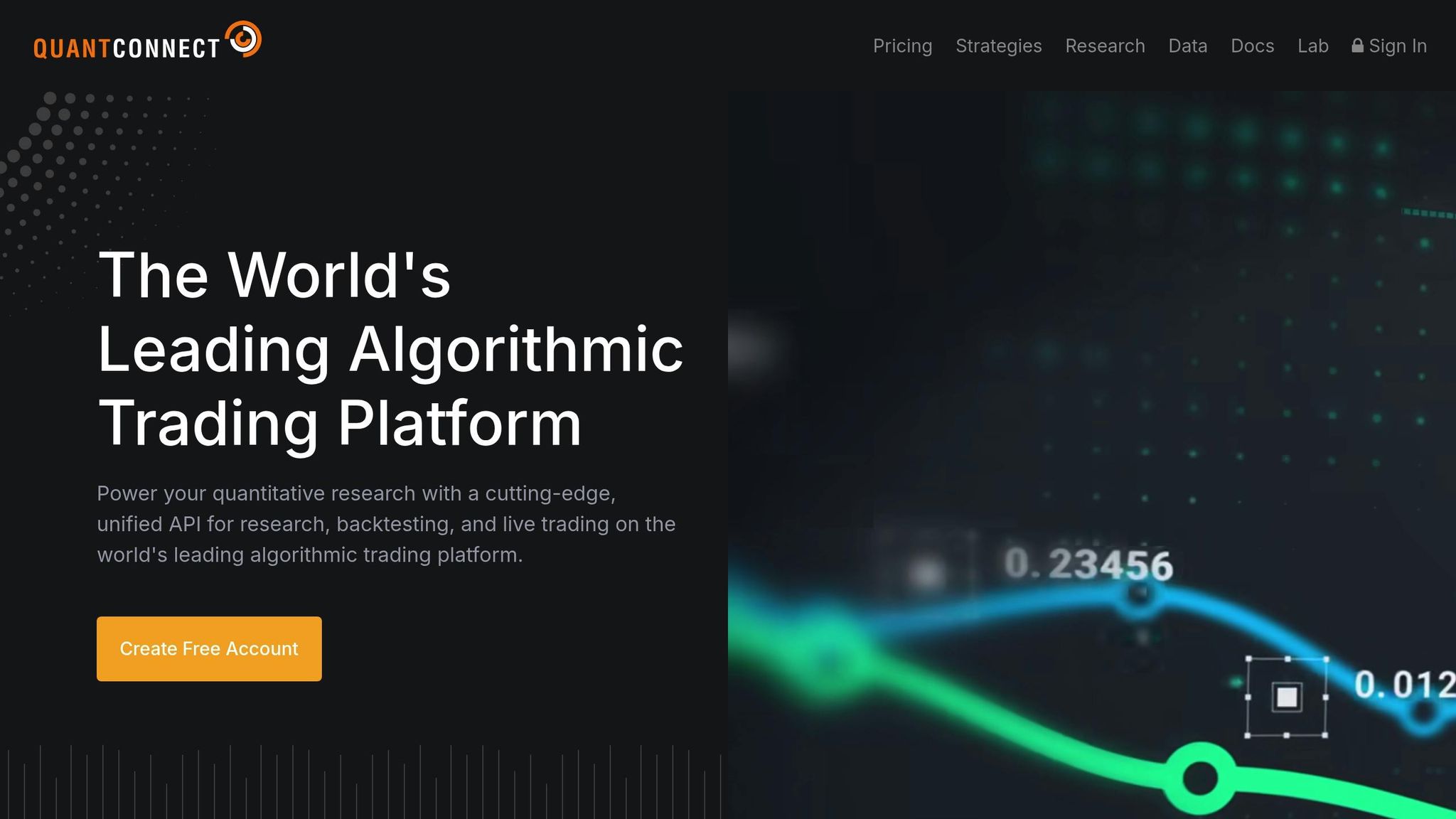
QuantConnect stands out as an open-source platform designed for researching, analyzing, and deploying algorithmic trading strategies. It supports multiple programming languages, making it accessible to developers with diverse coding skills.
The platform offers flexibility for users to run backtests, deploy research notebooks, and launch live algorithms either locally or in the QuantConnect Cloud. This adaptability makes it appealing for quants, developers, and traders who want to create, test, and implement strategies across various asset classes.
While QuantConnect provides a free tier, deploying live trading strategies does come with costs. The minimum subscription for live trading starts at $10 per month, which includes a backtest node and a live compute node. For more advanced features, the research tier is priced at $60 per month or $600 annually, and hosting Interactive Brokers with QuantConnect adds an extra $40 per month.
TradingView
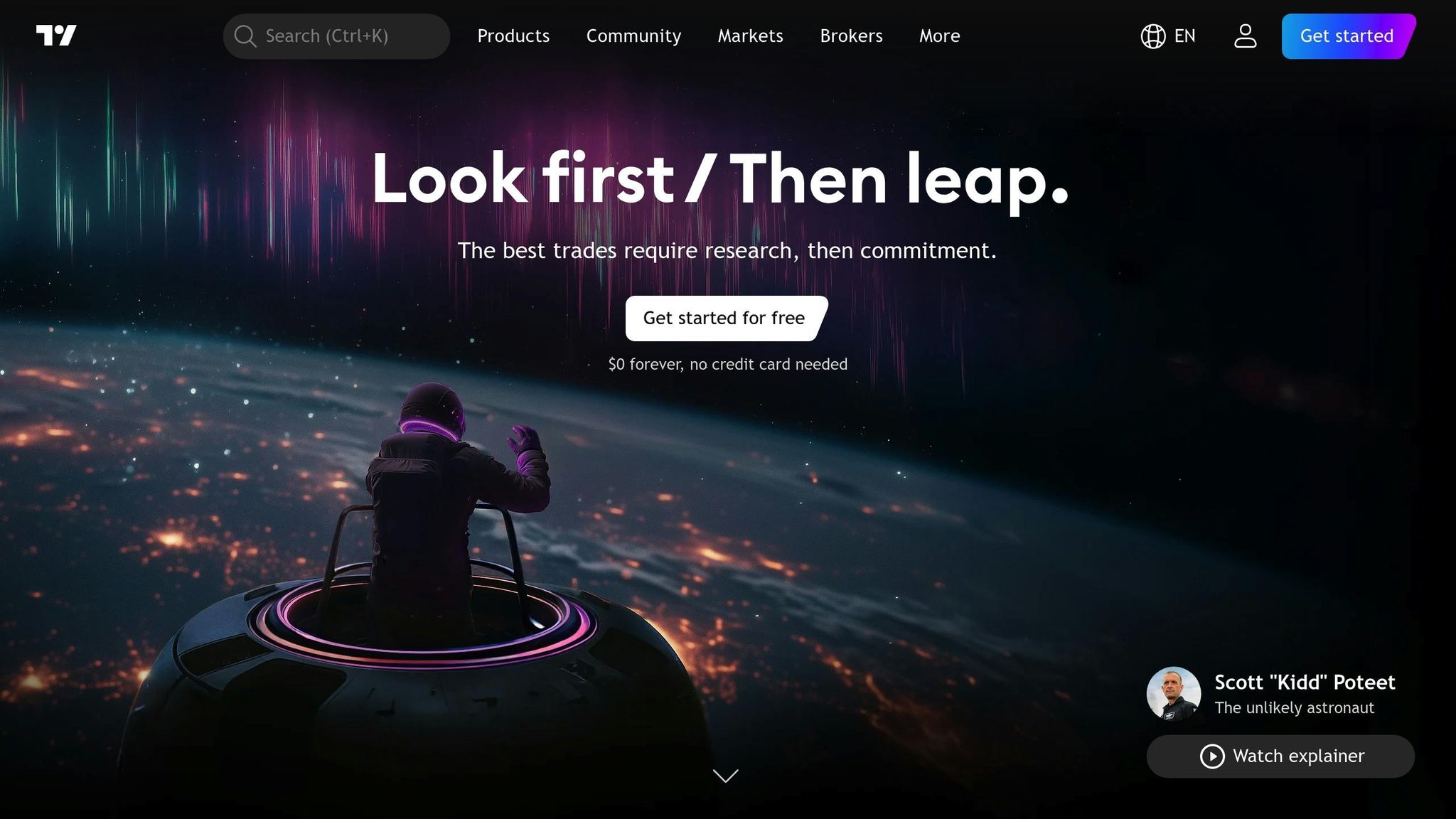
TradingView combines advanced charting with AI-powered customization, offering a seamless trading experience for its 100 million users. This browser-based platform allows traders to monitor markets, analyze charts, and test strategies all in one place. It boasts over 400 pre-built indicators and Pine Script, a coding language for creating custom indicators or strategies. Additionally, the platform includes features like paper trading for practicing with virtual funds and a replay option to review historical price movements.
In April 2025, Mastertrust highlighted five beginner-friendly features on TradingView: interactive charting tools, built-in technical indicators, smart alerts for real-time updates, social trading and community engagement, and Pine Script for personalized strategies. These tools empower users to analyze markets efficiently, test ideas with confidence, and learn from a global trading network.
TradingView is particularly well-suited for traders who rely on technical analysis to develop AI-assisted strategies. While the platform offers a free trial, its paid plans start at $12.95 per month.
Kavout
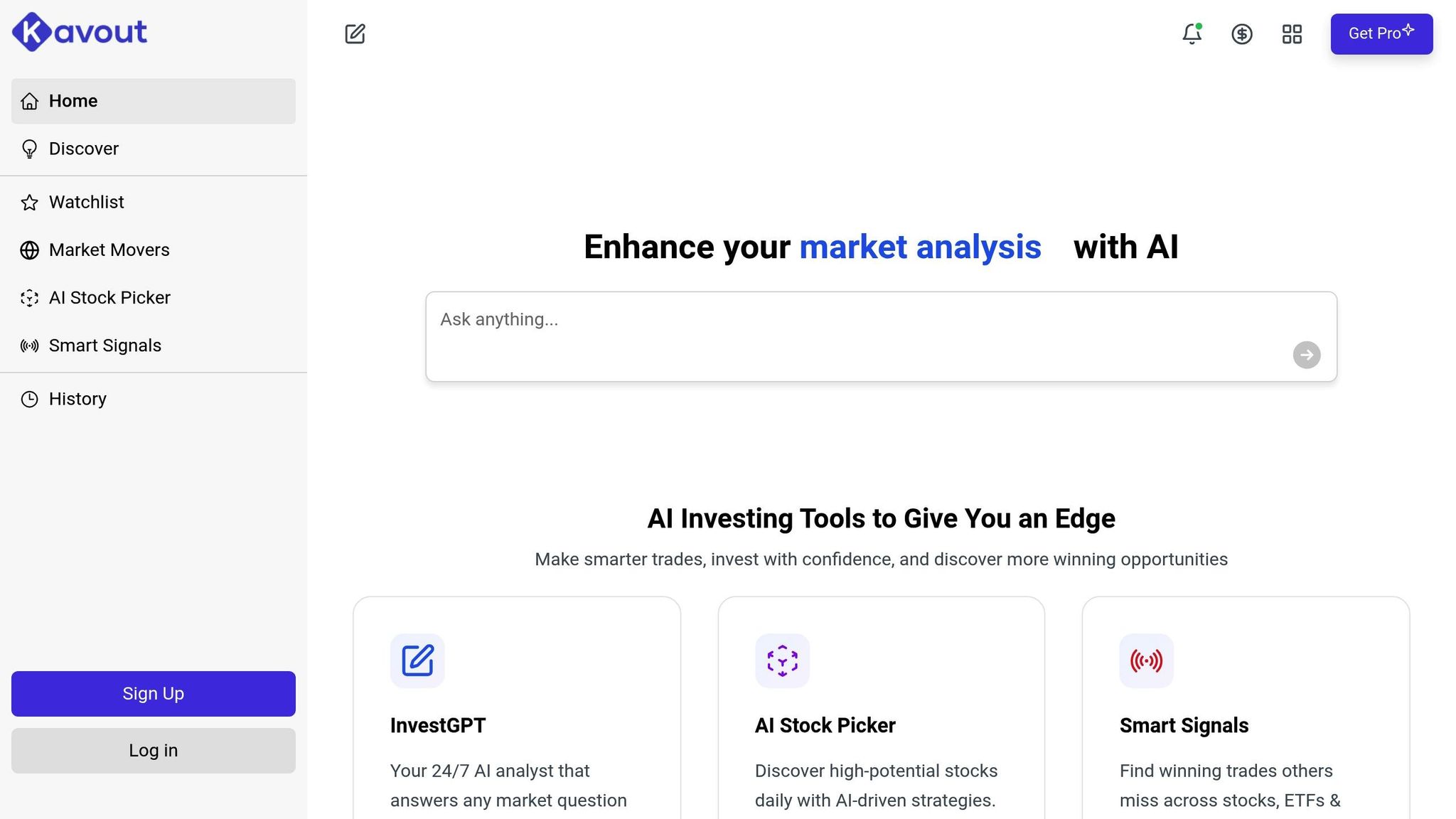
Kavout sets itself apart by focusing on deep learning and real-time insights. It delivers AI-powered portfolio analysis and trading signals, catering to both retail and institutional traders. By automating complex analysis and spotlighting high-potential trades, Kavout helps streamline decision-making.
The platform offers several tools tailored to different trading needs. Users can access InvestGPT for instant AI-driven insights, track market movers in real-time, and identify promising trades using the AI Stock Picker. Whether you're an active trader seeking momentum indicators, a long-term investor analyzing fundamentals, or a financial advisor needing client-ready reports, Kavout adapts to your workflow.
sbb-itb-2e26d5a
How Free AI Tools Improve Strategy Development and Execution
Free AI tools are reshaping how strategies are developed and executed by turning ideas into actionable plans at an incredible pace. Let’s dive into how their speed and efficiency can transform strategy testing and improvement.
Faster Strategy Testing and Improvement
AI-powered automation can condense what used to take months of manual testing into just minutes. Through intelligent configuration, backtesting, and optimization, these tools can quickly identify patterns in data, fine-tune indicators, and test multiple strategy variations across varying market conditions - all at the same time.
Industry professionals highlight this transformation:
"ChatGPT is nothing more than a tool. An extremely powerful tool, but a tool nonetheless. Similar to how a calculator doesn't transmute you into a mathematician, LLMs aren't going to transform you into a Wall Street Wizard overnight. But rather, a savvy trader using these tools can generate strategies faster, test them more meticulously, and bring them to the market more efficiently. A process that would have taken a trader months can now take them minutes." - Austin Starks
Real-world results back this up. For instance, portfolios generated by ChatGPT have outperformed traditional Buy and Hold strategies in backtesting, showing how AI can pinpoint and execute superior trading approaches. Additionally, hedge funds leveraging AI-driven technical analysis have reported better market performance and a stronger ability to predict trends.
Risk-Free Testing Through Simulations
Beyond speed, free AI tools offer a critical advantage: they minimize risk during strategy development. These tools provide simulation environments that allow strategies to be tested without financial exposure. By combining historical backtesting and real-time paper trading with live market data, traders can refine their approaches safely.
Backtesting evaluates strategies against historical data, focusing on metrics like ROI, Sharpe Ratio, maximum drawdown, and volatility. This process helps identify potential strengths and weaknesses before any real money is involved. Paper trading serves as a bridge between backtesting and live trading, reducing the likelihood of costly mistakes .
For the best outcomes, traders should follow these practices:
- Perform out-of-sample testing after backtesting to ensure the model works in new conditions.
- Begin with small live allocations before scaling up.
- Use demo accounts to familiarize themselves with platform features before investing real funds.
Making Quantitative Trading More Accessible
Free AI tools are also breaking down barriers in quantitative trading, making advanced tools available to a wider audience. What was once limited to large institutions is now within reach for individual traders and smaller firms. Currently, over 70% of institutional traders incorporate AI or machine learning into their strategies, and algorithms drive about 70% of trading volume in US markets. These tools are leveling the playing field.
They cater to a range of users, from beginners to seasoned coders, aligning with various technical skills and financial goals. Success depends on choosing tools that match your expertise and setting clear financial objectives. By combining human judgment with AI’s analytical power, traders can create a balanced approach that takes advantage of both perspectives.
As these tools continue to evolve, they’re making sophisticated quantitative trading strategies accessible to more people while maintaining the high-level analysis required for consistent results.
Benefits and Drawbacks of Free AI Trading Tools
Free AI trading tools come with a mix of advantages and challenges. The market for AI-driven trading solutions, valued at $18.2 billion in 2023, is expected to grow significantly, reaching $50.4 billion by 2033 - a testament to its rapid expansion. These tools build on the automated strategies and testing methods discussed earlier, offering both opportunities and limitations.
One of the biggest advantages of AI in trading is speed. It can execute trades in milliseconds, cutting transaction costs by up to 10% and improving decision-making consistency by 15–20%. AI also eliminates emotional biases like fear and greed, thanks to its objective, data-driven approach. Plus, with 24/7 market monitoring, traders can rest assured that no opportunities slip by unnoticed.
That said, these tools aren't without their flaws. They rely heavily on historical data, which can make them less effective during unprecedented events. The use of "black box" algorithms - where the decision-making process is unclear - can be another drawback, especially for traders seeking transparency. Additionally, standardized strategies may not align with individual risk profiles, and the systems require constant oversight to address potential flaws or cybersecurity risks.
It's also worth noting that success rates with AI trading tools aren't as high as one might hope. Only about 10–30% of traders using algorithmic or AI tools achieve consistent profitability in the long run, emphasizing the need for careful configuration and adaptive strategies.
Here’s a quick breakdown of the main benefits and drawbacks:
| Aspect | Benefits | Drawbacks |
|---|---|---|
| Speed | Executes trades in milliseconds; lowers costs by up to 10% | May react too quickly to false signals |
| Emotions | Removes fear and greed from decisions | Lacks human intuition for unique situations |
| Availability | Trades and monitors markets 24/7 | Requires constant monitoring and updates |
| Consistency | Improves decision consistency by 15–20% | Only 10–30% of users achieve long-term success |
| Transparency | Relies on data-driven decision-making | "Black box" algorithms lack clarity |
| Customization | Speeds up strategy development | Standardized strategies may not fit individual needs |
For traders thinking about using free AI tools, it's important to consider how well these tools align with your trading style, comfort with technology, and willingness to stay actively involved. While they excel at executing predefined strategies quickly and objectively, they can falter in unpredictable markets. Success often depends on blending AI's analytical capabilities with human judgment to create a trading approach that's both balanced and effective.
Conclusion: The Future of Free AI Tools in Quantitative Trading
Free AI tools are reshaping quantitative trading, a field once dominated by large institutions. By 2025, AI is projected to manage 89% of trading volume, with the market size expected to hit $35 billion by 2030. These numbers align with expert views on AI’s growing influence across industries.
More than just making trading accessible, AI is transforming how data is processed and decisions are made. Laurence Fink, CEO of BlackRock, highlights the game-changing potential of AI in these areas. Open-source frameworks and collaborative platforms are also playing a key role, offering advanced trading algorithms to a broader audience and reducing dependency on costly proprietary systems.
Looking forward, advancements in explainable AI, natural language processing, quantum computing, and emotional AI are set to bring greater transparency, faster execution, and better market sentiment analysis. These developments build on the improvements in strategy testing and execution we've already seen.
AI isn’t here to replace traders - it’s here to work alongside them. By handling complex data processing, AI allows professionals to focus on strategic thinking. This collaboration addresses current system challenges while keeping the critical human judgment needed for navigating ever-changing markets.
For traders, staying informed and adaptable is key. Choosing the right tools is crucial, and resources like the Best Investing Tools Directory offer in-depth reviews of AI-powered trading platforms, charting tools, and technical analysis software to help make smarter decisions.
The future of quantitative trading is undeniably tied to AI. Success will depend on finding the right mix of cutting-edge tools and human expertise.
FAQs
How do free AI tools for quantitative trading compare to those used by major financial institutions?
Free AI tools for quantitative trading are built to be straightforward and accessible, making them a great choice for retail traders and smaller investors. These tools typically offer features like automation, backtesting, and real-time data analysis, enabling users to design and implement trading strategies without spending a fortune.
On the other hand, the tools employed by large institutions are on an entirely different level. They come equipped with advanced data integration, lightning-fast execution, and sophisticated risk management systems. These platforms are specifically designed for professional traders handling substantial assets, allowing them to execute large-scale strategies with precision and efficiency. While free AI tools open the door for more people to participate in quantitative trading, institutional platforms stand out by delivering unmatched speed, accuracy, and scalability.
What are the risks and challenges of using AI tools for trading strategies?
AI tools can certainly improve trading strategies, but they aren't without their risks and challenges. For starters, technical issues like system crashes or execution errors can interrupt trades and potentially cause financial losses. On top of that, AI models might sometimes produce inaccurate or misleading recommendations, leading to poor investment decisions.
There are also broader concerns to consider. Some AI algorithms operate as "black-box" systems, making their processes difficult to understand - a lack of transparency that can be problematic. Over-reliance on automation is another risk, as is the exposure to cybersecurity threats that could compromise sensitive trading data.
To address these challenges, it’s essential to keep a close eye on AI systems, double-check their outputs, and ensure you fully understand how they work before integrating them into your trading strategy. A hands-on approach can help strike the right balance between leveraging AI's advantages and staying in control of your investments.
Can AI tools fully replace human judgment in quantitative trading, or do humans still play a critical role?
AI tools have transformed quantitative trading by analyzing massive datasets and executing trades with unmatched speed and accuracy. Yet, they fall short in areas like interpreting market sentiment, evaluating geopolitical risks, or reacting to sudden news events - tasks that rely heavily on human intuition.
This is where human oversight becomes indispensable. It helps to identify biases, uphold ethical standards, and make strategic calls in situations that are too complex or unpredictable for AI alone. While AI boosts efficiency and precision, its true potential shines when paired with human judgment to craft a well-rounded and effective trading strategy.
